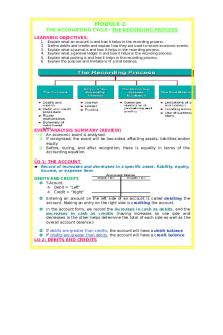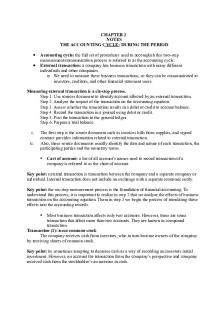4. The Accounting Cycle - closing the books PDF

| Title | 4. The Accounting Cycle - closing the books |
|---|---|
| Course | Accounting Concepts |
| Institution | University of Auckland |
| Pages | 4 |
| File Size | 433.1 KB |
| File Type | |
| Total Downloads | 91 |
| Total Views | 185 |
Summary
Lecturer: Glenn Rechtschaffen
Course taken: 2016
Use these notes and you will have no difficulty understanding Acctg102....
Description
MODULE 4. THE ACCOUNTING CYCLE: COMPLETING THE CYCLE LEARNING OBJECTIVES: 1. 2. 3. 4. 5.
Explain the process of closing the books. Describe the content and purpose of a post-closing trial balance. State the steps in the accounting cycle. Explain the approaches to preparing correcting entries. Revisit the content and format of the SOCI and Statement of Financial Position.
LO 1: CLOSING THE BOOKS CLOSING JOURNAL ENTRIES Nature: basically allows the business to set certin accounts back to zero [helps with comparability] Purpose: to make sure for certain accounts (esp. revenue and expense accounts), they are reset back to zero, ready again to measure/ accumulate for the particular accounting period they are completing the cycle for/ that the business is interested in At the end of the accounting period, the company makes the accounts ready for the next period
Temporary accounts relate to only given accounting period Permanent accounts are carried forward to future accounting periods [these are NOT closed from period to period] PREPARING CLOSING ENTRIES Closing entries formally recognise, in the general ledger, the transfer of net income (or net loss) and dividends to Reatined Earnings. Closing entries are only at the end of the annual accounting period Closing entries also produce a zero balance in each temporary account The temporary accounts are then ready to accumulate data in the next accounting period separate from the data prior periods [permanent accounts are not closed]
Journalising and posting closing entries is a required step in the accounting cycle. The company performs this step after it has prepared financial statements. Companies generally journalize and post closing entries only at the end of the annual accounting period. Thus, all temporary accounts will contain data for the entire year.
In preparing closing entries, companies close each income statement account directly to Retained Earnings – however, to do so would result in excessive detail in the Retained Earnings account. Instead, companies close the revenue and expense accounts to another temporary account “Income Summary,” and they transfer the resulting net income or net loss from this account to Retained Earnings. Companies record closing entries in the general journal
Companies generally prepare closing entries directly from the adjusted balances in the ledger. The following four entries accomplish the desired result more efficiently: Debit each revenue account for its balance, and credit Income Summary for total revenues Debit Income Summary for total expenses, and credit each expense account for its balance Debit Income Summary and credit Retained Earnings for the amount of net income Debit Retained Earnings for the balance in the Dividens account, and credit Dividends for the same amount
Posting Closing Entries
The Income Summary account is used only in closing
LO 2: PREPARING A POST-CLOSING TRIAL BALANCE POST-CLOSING TRIAL BALANCE The post-closing trial balance lists permanent accounts and their balances after journalizing and
posting of closing entries. The purpose of the post-closing trial balance is to prove the equality of the permanent account balances carried forward into the next accounting period. Since all temporary accounts will have zero balances, the post-closing trial balance will contain only permanent statement of financial positionaccounts. A post-closing trial balance provides evidence that the company has properly journalized and posted the closing entries. It also shows that the accounting equation is in balance at the end of the accounting period. However, like the trial balance, it does not prove that the business has recorded all transactions or that the ledger is correct. For example, the post-closing trial balance will balance if a transaction is not journalized and posted or if a transaction is journalized and posted twice.
LO 3: THE ACCOUNTING CYCLE
LO 4: CORRECTING ENTRIES – AN AVOIDABLE STEP Unfortunately, errors may occur in the recording processs. Companies should correct errors as soon as they discover them, by journalising and posting correct entries. If the accounting records are free of errors, no correcting entries are needed. CORRECTING ENTRIES Are unnecessary if the records are error-free. Are made whenever an error is discovered. Must be posted before closing entries are journalised and posted. Instead of preparing a correcting entry, it is possible to reverse the incorrect entry and then prepare the correct entry. **GOOD TO NOTE** You should recognize several differences between correcting entries and adjusting entries. First, adjusting entries are an integral part of the accounting cycle. Correcting entries, on the other hand, are unnecessary if the records are error-free. Second, companies journalize and post adjustments only at the end of an accounting period. In contrast, companies make correcting entries whenever they discover an error. Finally, adjusting entries always affect at least one statement of financial position account and one income statement account. In contrast, correcting entries may involve any combination of accounts in need of correction....
Similar Free PDFs

Completing the Accounting Cycle
- 152 Pages

Ch04 Completing the Accounting Cycle
- 73 Pages

The Iliad Books 1-4
- 2 Pages

Chapter 4 The Revenue Cycle
- 8 Pages

Closing the Gap Report 2021
- 52 Pages

homer\'s the odyssey books 1-4
- 2 Pages
Popular Institutions
- Tinajero National High School - Annex
- Politeknik Caltex Riau
- Yokohama City University
- SGT University
- University of Al-Qadisiyah
- Divine Word College of Vigan
- Techniek College Rotterdam
- Universidade de Santiago
- Universiti Teknologi MARA Cawangan Johor Kampus Pasir Gudang
- Poltekkes Kemenkes Yogyakarta
- Baguio City National High School
- Colegio san marcos
- preparatoria uno
- Centro de Bachillerato Tecnológico Industrial y de Servicios No. 107
- Dalian Maritime University
- Quang Trung Secondary School
- Colegio Tecnológico en Informática
- Corporación Regional de Educación Superior
- Grupo CEDVA
- Dar Al Uloom University
- Centro de Estudios Preuniversitarios de la Universidad Nacional de Ingeniería
- 上智大学
- Aakash International School, Nuna Majara
- San Felipe Neri Catholic School
- Kang Chiao International School - New Taipei City
- Misamis Occidental National High School
- Institución Educativa Escuela Normal Juan Ladrilleros
- Kolehiyo ng Pantukan
- Batanes State College
- Instituto Continental
- Sekolah Menengah Kejuruan Kesehatan Kaltara (Tarakan)
- Colegio de La Inmaculada Concepcion - Cebu









